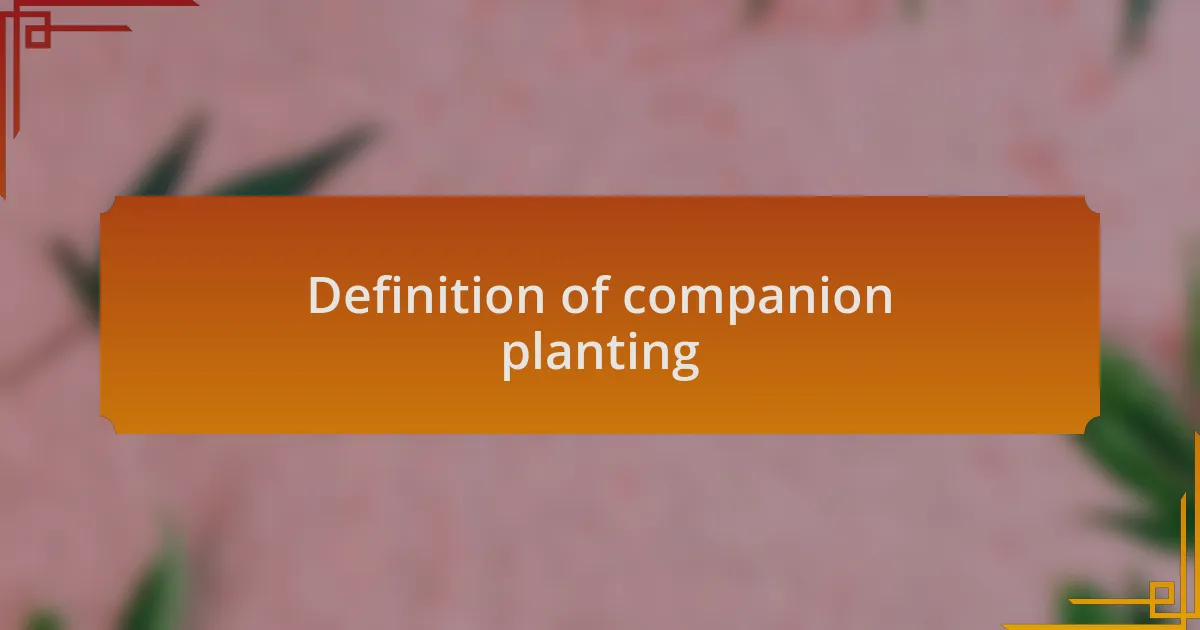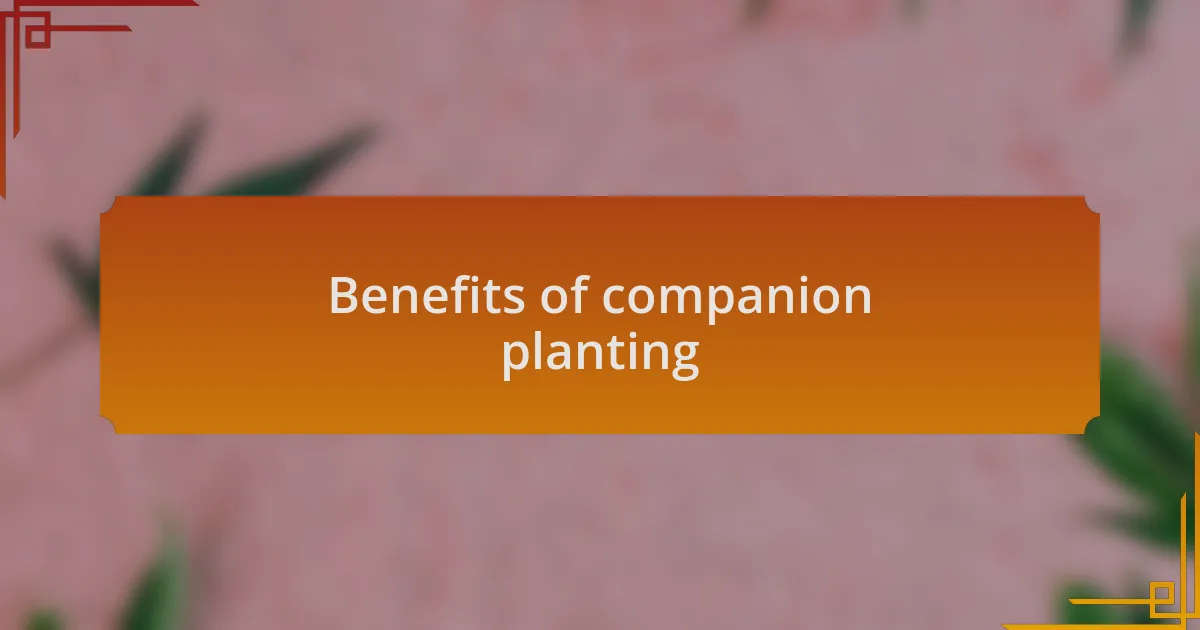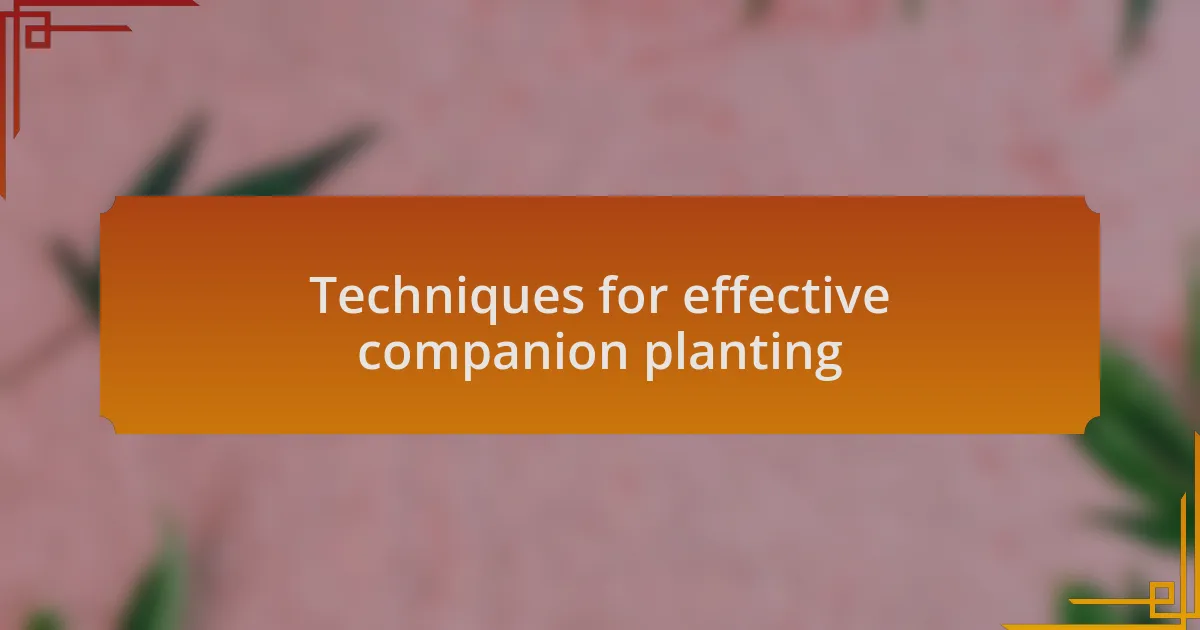Key takeaways:
- Companion planting involves strategically growing different plants together to enhance growth, deter pests, and improve flavor in the garden.
- Beneficial combinations, such as cannabis with basil, marigolds, or garlic, can lead to healthier plants and reduce pest issues.
- Using techniques like careful placement, staggered planting, and mulching with companion plants can significantly enhance gardening outcomes.
- Understanding plant relationships fosters a balanced ecosystem, creating a more vibrant and productive garden environment.

Definition of companion planting
Companion planting involves growing different plants close together for mutual benefits. This practice can enhance growth, deter pests, and even improve flavor. It’s fascinating how certain plants can support one another, almost like they communicate and work together in their own green symphony.
I remember my first garden experience when I decided to plant basil next to my tomatoes. Not only did the basil thrive, but I noticed fewer pests around my tomatoes as well. Have you ever thought about how plants can actually create a more balanced ecosystem when paired strategically?
The beauty of companion planting lies in its simplicity and effectiveness. By understanding the relationships between plants, growers can tap into nature’s wisdom. It’s like forming a little community in your garden where each member plays a vital role, contributing to the health and productivity of the whole.

Benefits of companion planting
Companion planting offers numerous benefits that can significantly enhance your gardening experience. For instance, certain plants, like marigolds, can deter harmful pests such as aphids and nematodes while attracting beneficial insects. I remember incorporating marigolds in my garden, and it felt rewarding to see fewer pests while my cannabis plants thrived alongside them. Have you noticed how a vibrant, diverse garden can feel alive and robust?
Moreover, companion planting can improve the nutrient availability in your soil. Some plants, such as legumes, enrich the soil with nitrogen, which is a vital nutrient for cannabis growth. I noticed this firsthand when I paired my cannabis plants with clover; the soil quality improved, and in turn, my plants grew stronger and more resilient. Isn’t it incredible how the right combinations can transform your growing conditions?
Lastly, this practice not only maximizes space but can also enhance flavor and yield. For example, pairing herbs with cannabis can create a delightful aromatic experience while cooking. I recall experimenting with rosemary and finding that it not only reduced pests but also added a unique flavor to dishes made with my homegrown cannabis. When you think about it, isn’t gardening about creating harmonious relationships that benefit all?

Companion planting for cannabis
When it comes to companion planting for cannabis, I’ve found that pairing cannabis with basil can work wonders. After it became a staple in my garden, I observed not only the heightened flavors in my harvest but also how the fragrant basil seemed to shield my cannabis plants from pests like spider mites. Have you ever considered how a simple culinary herb can contribute to the overall health of your cannabis crop?
Another dynamic duo I’ve experimented with is cannabis and yarrow. This herb has a knack for improving the immune response of nearby plants, including cannabis, which made me feel like I was not just growing plants but nurturing a thriving ecosystem. I remember noticing that the vibrant yarrow combined with my cannabis plants created an inviting microenvironment for pollinators, making my garden feel increasingly alive. Isn’t it amazing how nature can work in such harmonious balance?
In addition to these pairings, I’ve learned that the timing of planting is just as crucial. When I planted my cannabis alongside sunflowers, I noticed that the sunflowers not only attracted pollinators but also provided shade during the hottest parts of the day. This protective measure resulted in healthier cannabis plants and a more enjoyable gardening experience. Have you ever tried planting taller companions to create shade in your garden? The right timing and planning can truly elevate your growing journey.

Suitable companions for cannabis
Pairing cannabis with chamomile has become one of my favorites. I recall the delightful scent wafting through my garden as the delicate flowers bloomed. Not only did it create an enchanting visual, but I also noticed that chamomile seemed to promote a stronger overall health in my cannabis plants, as they appeared more vibrant and resilient. Have you ever experienced the peaceful feeling that a well-balanced garden can bring?
Another excellent companion I’ve come to appreciate is the marigold. I distinctly remember how the bright, cheerful blooms captivated not only my eyes but also an array of beneficial insects. The marigolds acted as a natural pest repellent, drawing unwanted bugs away from my cannabis while simultaneously attracting those that were advantageous. It felt rewarding to see my plants thrive together as if they were supporting one another through the subtle yet powerful connections of nature.
I’ve also experimented with planting garlic near my cannabis. From my experience, the strong aroma of garlic seems to deter pests effectively; I can’t tell you how relieved I felt when I realized I didn’t have to worry as much about aphids. Plus, the vibrant green shoots looked stunning next to my cannabis plants! Isn’t it fascinating how certain plants can work together so symbiotically, enhancing not just their growth, but the overall garden environment?

Techniques for effective companion planting
When it comes to techniques for effective companion planting, I’ve found that careful placement is essential. For instance, I remember relocating my basil closer to my cannabis plants and was surprised by the difference it made. Not only did the aroma create a more inviting atmosphere, but the basil’s natural oils seemed to repel pests, allowing my cannabis to flourish without as many interruptions.
Another technique I have relied on is practicing staggered planting to maximize space and benefits. I often plant my cannabis alongside a few fast-growing herbs like cilantro. This combination not only utilizes the garden space effectively but also enhances humidity levels, creating a microclimate that can be particularly beneficial on warmer days. Have you ever noticed how a well-planned arrangement can transform your gardening experience?
Additionally, I’ve experimented with using mulch derived from companion plants, which has been a game-changer. For example, incorporating crushed leaves from my marigolds as mulch not only suppresses weeds but also enriches the soil with nutrients. Seeing the health of my plants improve as a direct result of this practice made me realize just how interconnected the ecosystem of my garden truly is.